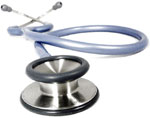Varicose veins
Varicose veins are dilated, tortuous,
superficial veins in the lower limb which occur in association with the course
of the long saphenous vein and the short saphenous vein. The prevalence of varicosities is
80% in people over the age of 60. Around 12% of these are symptomatic.
|
Symptoms |
Signs |
|
Pain and
cramping in the affected leg which is worse after prolonged standing. Concern
about the cosmetic appearance. Patient feels they have ugly legs. |
Varicose
eczema Varicose
ulcers Haemorrhage Haemosiderin
skin pigmentation Phlebitis
(often recurrent) Ankle
oedema |
Examination
- Stand the patient up and
observe, looking for; ulceration, haemosiderin, eczema, thin skin.

- Palpate for; tenderness over
varices (phlebitis) or hardness (thrombosis).
- Determine the location of the
filling insufficiency using a tourniquet test:
- Elevate the limb to empty
veins
- Place a tourniquet around the
thigh and the stand the patient up
- If filling of the varicose
vein is controlled then the main filling communication is at the
saphenofemoral junction.
- If filling not controlled
repeat the test with the tourniquet above the knee.
- If this controls filling then
the communication is via the mid thigh perforating vein.
- If filling is not controlled
repeat the test with the tourniquet just below the knee.
- If this controls filling then
the communication is via the popliteal perforating veins.
- If filling remain uncontrolled
then more distal perforating veins are responsible.
- Further examination may include
Perthes’ test and duplex ultrasound.
Management
- Conservative: Advise
the patient to avoid standing for long periods, wear support stockings,
loose weight and take regular walks.
- Medical: Injected sclerosants (little
evidence of benefit when used as sole treatment)
- Surgical: Includes high saphenous
ligation, saphenous stripping, multiple avulsions.
